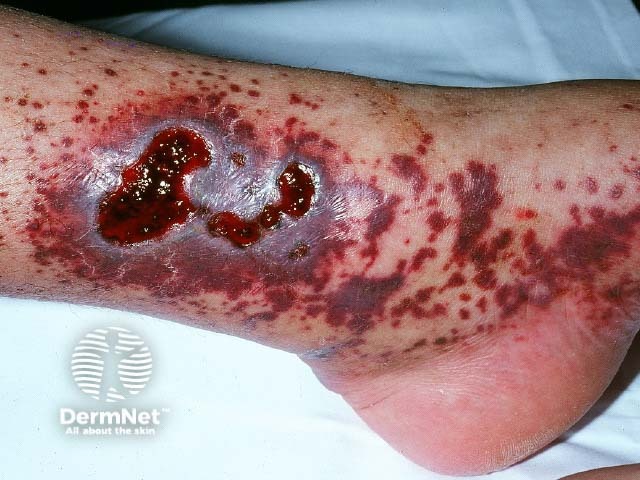Main menu
Common skin conditions

NEWS
Join DermNet PRO
Read more
Quick links
Prophylactic treatment for dermatology patients on a systemic corticosteroid — extra information
Prophylactic treatment for dermatology patients on a systemic corticosteroid
Author(s): Lauren Smith, Medical Student, University of Otago Christchurch, Christchurch, and Dr Adrian Sykes, Dermatology Registrar, Waikato Hospital, Hamilton, New Zealand. DermNet New Zealand Editor in Chief: Hon A/Prof Amanda Oakley, Dermatologist, Hamilton, New Zealand. Copy edited by Maria McGivern. July 2017.
What is a systemic corticosteroid?
A systemic corticosteroid (or ‘steroid’) is a drug derived from cortisol, a natural steroid produced by the adrenal gland in the body. Systemic steroids are prescribed in dermatology for inflammatory skin diseases, such as:

Discoid eczema

Bullous pemphigoid

Cutaneous vasculitis
Risks from long-term systemic corticosteroid use
There are risks from the long-term effects of treatment with systemic steroids, including infections (bacterial, fungal and viral), hypertension, diabetes, osteoporosis, avascular necrosis, myopathy, and glaucoma.
There are several ways some of these risk factors can be reduced, including through continual assessment and monitoring, lifestyle changes, and prophylactic treatments.
The risks detailed below refer to patients treated with > 7.5 mg/day of prednisone (or equivalent doses of other corticosteroids) for periods of time greater than 3 months. Below these levels, the risk of health effects is negligible.
Effects on bone health
Systemic steroids stimulate bone resorption (breakdown) and reduce bone formation within the first few months of initiating treatment, which increases the risk of osteoporosis and fracture [1,2].
Assessments
An assessment of bone mineral density (BMD) at the lumbar spine and/or the hip should be taken at the initiation of systemic steroids.
Consider a falls assessment for those individuals at increased risk of falls.
Blood tests are not usually necessary, but you could assess:
- Vitamin D levels, using a 25-hydroxy vitamin D blood test (aiming for > 50 ng/mL)
- Calcium levels.
Lifestyle advice
The risk of developing osteoporosis can be reduced through the implementation of lifestyle changes. These include:
- The introduction of weight-bearing and bone-loading exercises
- Smoking cessation
- A diet high in calcium
- Avoidance of excessive alcohol (> 3 standard drinks/day is detrimental to bone health); New Zealand Ministry of Health recommendations are as follows:
- Women: 2 standard drinks/day, < 10 standard drinks/week
- Men: 3 standard drinks/day, < 15 standard drinks/week
- At least 2 alcohol-free days per week [3].
Prevention of osteoporosis
The prevention of osteoporosis is controversial. A bisphosphonate (eg, alendronic acid, risedronate sodium, or zoledronic acid) is first-line therapy if the BMD-measured T-score is < −1 (ie, showing osteopenia or low bone mass) [4,5]. Osteoporosis is a T-score of < −2.5.
Bisphosphonates are also recommended for patients taking ≥ 7.5 mg/day of prednisone (or equivalent) for ≥ 3 months’ duration if they are in the following categories [4,5]:
- Postmenopausal women and men ≥ 50 years
- Premenopausal women and men < 50 years with a history of fragility fracture.
Other options for osteoporosis
- Calcium carbonate (1000–1500 mg/day) supplementation is recommended only if consumption is inadequate through diet [1,5].
- Vitamin D3 (800 IU/day) supplementation is recommended in those with very low skin exposure to sunlight (see vitamin D).
- Calcitonin is second-line therapy on specialist advice and may be recommended if bisphosphonates are not suitable or if patient has sustained an acute fracture (it reduces bone pain) [1].
- Parathyroid hormone analogue (teriparatide 10 mg/day) is often used in the treatment of osteoporosis rather than for prophylaxis.
- Hormone replacement may be recommended for premenopausal women with menstrual irregularities, but data for its use on postmenopausal women are insufficient to recommend it for prophylactic use [5–7].
Prevention of osteoporosis in children
There are currently no evidence-based guidelines for the prevention and treatment of steroid-induced osteoporosis in children. Currently experts recommend [4]:
- Proper nutrition
- Maintenance of a healthy weight
- Promotion of weight-bearing exercise
- Vitamin D supplementation to achieve at least 50 nmol/L, ideally 75 nmol/L (if measured)
- Calcium supplementation (if diet is inadequate)
- Long-term safety data are still required on bisphosphonate use in children; however, they are currently recommended by experts for use in children with evident bone fragility and reduced BMD.
Cardiovascular disease
The use of systemic steroids is associated with hypertension, hyperglycaemia and obesity, which are risk factors for ischaemic heart disease and heart failure.
Assessments
Assess the patient’s current risk factors for cardiovascular disease (CVD); this will include assessing:
- Blood pressure
- Cholesterol levels
- Physical activity levels and diet
- Any family history of CVD, type 2 diabetes, and genetic lipid disorders
- The patient’s past medical history, including any previous heart attacks, strokes, atrial fibrillation, or renal impairment
- Smoking status
-
Diabetes status/blood glucose levels:
- Fasting plasma glucose 4–7 mmol/L recommended
- 2-hour plasma glucose 5–10 mmol/L recommended.
Lifestyle advice
The risk of the patient developing CVD can be reduced through the following lifestyle factors:
- Diet:
- Restricting sodium intake
- Eating potassium-rich foods (eg, broccoli, carrots, fish and poultry)
- Consuming a diet high in fibre and whole grains
- Reducing cholesterol intake
- Weight loss if required (calculate body mass index)
- Eating a diet low in saturated fats [8]
- Smoking cessation
- Physical activity; aim for:
-
- 2.5 hours of moderate intensity a week OR
- 1.25 hours of vigorous intensity a week [8].
- 2.5 hours of moderate intensity a week OR
-
Prevention of cardiovascular disease
Calculate the patient’s cardiovascular risk. If the outcome of your calculations presents their risk as:
- Low: promote lifestyle changes
- Moderate: discuss the benefits and harms of blood pressure and/or lipid-lowering drugs, and lifestyle changes
-
High: discuss with these patients how they are likely to benefit from blood pressure and lipid-lowering medications, as well as antiplatelet drugs, and intensive lifestyle interventions. Prescriptions may include:
- Antiplatelet therapy (aspirin)
- Statins (lipid-lowering)
- Thiazide diuretics — these reduce hypertension and osteoporotic risk long term [1].
- Aim for the following targets with patients at high risk of CVD:
- Blood pressure < 130/80 mmHg
- Low-density lipoprotein cholesterol < 2.0 mmol/L.
Assess the patient’s lipid profile at baseline, after 1 month, and then every 6–12 months after the initiation of systemic steroids. The Framingham Risk Score can be used to assess an individual’s 10-year risk of developing CVD, and can be used to guide treatment [4].
Hyperglycaemia
The use of systemic steroids has effects on glucose levels within hours, and is associated with hyperglycaemia and insulin resistance [4].
Assessment
Assess the patient’s blood glucose levels. The recommended ranges are:
- Fasting plasma glucose: 4–7 mmol/L
- 2-hour plasma glucose: 5–10 mmol/L.
Glycosylated haemoglobin (HbA1c) is a measure of blood glucose over the preceding 3 months. The level of HbA1c indicates the risk of diabetes:
- < 40 mmol/mol: no diabetes
- 40–50 mmol/mol: insulin resistance or “pre-diabetes”
- > 50 mmol/mol: diabetes.
Treatment of hyperglycaemia
If the blood glucose levels are not within the normal ranges, initial management should be the implementation of lifestyle modification strategies as described for CVD. If blood glucose targets are not met, glucose-lowering medications are recommended.
Random plasma glucose > 11 and < 15 mmol/L should be treated with one of the following medications (as with pre-existing type 2 diabetes):
- Metformin
- Dipeptidyl peptidase-4 inhibitors
- Sulfonylureas: sulfonylureas with a short half-life (eg, gliclazide) are suitable for patients on once-daily prednisone; drugs with longer half-lives (eg, gliclazide modified release) are suitable for those on shorter-acting steroids administered more than once daily
- Glucagon-like peptide-1.
If blood glucose levels are > 15 mmol/L, insulin may be required to control glycaemia.
Steroid-induced diabetes in children will require advice from a multidisciplinary paediatric diabetes healthcare team. Lifestyle interventions are first-line therapy, followed by insulin [4].
Gastrointestinal disease
Systemic corticosteroids can cause an increased risk of gastrointestinal events, such as gastritis, peptic ulcer, and gastrointestinal haemorrhage [1,4].
Assessment
Assess the patient’s history of risk factors for peptic ulcer [5]; these include:
- NSAID use (increases peptic ulcer incidence four-fold)
- Smoking
- Helicobacter pylori infection
- Alcohol use
- Age > 65 years
- Current or previous peptic ulcer disease
- Serious comorbidities, such as advanced cancer.
Prevention of gastrointestinal disease
Following a thorough assessment, if you think a patient is at high risk of gastrointestinal disease, consider prescribing a H2 receptor antagonist or a proton-pump inhibitor [4].
Immunosuppression
The use of systemic steroids directly affects immune cells, such as T-lymphocytes, and the immune system cannot respond to infection as effectively as normal, leading to an increased risk of infection [4].
Encourage the patient to present to you early if they are unwell.
Assessment
Take an immunisation history, covering the patient’s routine childhood and adult vaccines, before initiating therapy; routine vaccines include [9]:
- Influenza vaccine
- Hepatitis A and B
- Rotavirus
- Diphtheria, tetanus and pertussis
- Haemophilus influenzae type b
- Human papillomavirus
- Herpes zoster (shingles)
- Pneumococcal
- Measles, mumps, and rubella.
Any testing for chronic infection should include:
- Hepatitis B virus and hepatitis C virus serology
- HIV serology
- Tuberculosis screening, using a purified protein derivative (PPD) skin test or QuantiFERON Gold blood test [5].
Preventing infection
Infection can be minimised by frequent hand washing, avoiding exposure to others with infection, and the use of appropriate vaccines.
Give missing or indicated vaccines before initiating systemic steroid therapy. Give live vaccines at least 2–4 weeks beforehand, as systemic steroids reduce the efficacy and increase the risk associated with vaccines [5].
Avascular necrosis
Avascular necrosis occurs when there is loss of blood flow to the bone, leading to infarction of the bone, often at the femoral head. The risk of developing osteonecrosis increases with increased doses of systemic corticosteroids [5].
Assessment
Assess the patient’s previous medical history for risk factors for avascular necrosis; risk factors include:
- Sickle-cell haemoglobinopathies
- Systemic lupus erythematosus
- Renal transplantation
- Gout
- HIV infection
- Hypercoagulable states
- Trauma
- Antiphospholipid antibodies.
Ask about the patient’s alcohol consumption, as this can increase risk of avascular necrosis. Recommend they avoid excessive alcohol consumption.
Monitor patients with an elevated risk of avascular necrosis closely.
Monitoring
Monitor any joint pain and the range of motion in the joint as early diagnosis and appropriate intervention can prevent or delay the progression of avascular necrosis [1].
If avascular necrosis is suspected, you can diagnose using:
- An MRI of the affected joint [1,5]
- Referral to rheumatology if concerned [1].
Treatment of avascular necrosis
Treatment of avascular necrosis initially involves:
- Partial weight-bearing activities
- Bed rest
- Analgesics to relieve pain.
If conservative management fails, additional options can be considered, such as surgery [1].
Behavioural and cognitive changes
The use of systemic steroids may alter the patient’s mood or cause memory deficit, agitation, anxiety, lethargy and psychosis [1,4].
Assessment
The patient must be screened for any of the following risk factors:
- A family history of depression or alcoholism
- Systemic lupus erythematosus
- Pre-existing psychiatric disorders.
Low serum albumin levels are a predictor of psychosis in patients with systemic lupus erythematosus [1,4].
Monitor any changes in the patient’s behaviour or cognitive status.
Treatment of behavioural disorders
Lithium carbonate can be used as prophylaxis for psychosis in those patients who are predisposed to psychosis [1,4].
Persistent symptoms of psychosis may indicate antipsychotic therapy is required. Most patients recover with either dose reductions or cessation of systemic steroids.
If a patient experiences sleep disturbances and unpleasant dreams, consider changing their dose of systemic steroids to a single morning dose, or administer drugs with sedative effects at night [4].
References
- Moghadam-Kia S, Werth VP. Prevention and treatment of systemic glucocorticoid side effects. Int J Dermatol 2012; 49: 239–48. DOI: 10.1111/j.1365-4632.2009.04322.x. PubMed Central
- Sewerynek E, Stuss M. Steroid-induced osteoporosis. Aging Health 2012; 8: 471–7. Medscape
- New Zealand Ministry of Health. Alcohol. April 2016. Available at: www.health.govt.nz/your-health/healthy-living/addictions/alcohol-and-drugs/alcohol (accessed 3 April 2017).
- Liu D, Ahmet A, Ward L, et al. A practical guide to the monitoring and management of the complications of systemic corticosteroid therapy. Allergy Asthma Clin Immunol 2013; 9: 30. DOI: 10.1186/1710-1492-9-30. PubMed Central
- Caplan A, Fett N, Rosenbach M, Werth VP, Micheletti RG. Prevention and management of glucocorticoid-induced side effects: A comprehensive review: A review of glucocorticoid pharmacology and bone health. J Am Acad Dermatol 2017; 76: 1–9. DOI: 10.1016/j.jaad.2016.01.062. PubMed
- Buckley L, Greenwald M, Hochberg M, et al. American College of Rheumatology Ad Hoc Committee on Glucocorticoid-Induced Osteoporosis. Recommendations for the prevention and treatment of glucocorticoid-induced osteoporosis. Arthritis Rheumatol 2001; 44: 1496–1503. Journal
- Schneider HPG. General aspects of worldwide HRT use. In: Kato J, Minanguchi H, Nishino Y. Hormone replacement therapy and osteoporosis. Ernst Schering Research Foundation Workshop Supplement 4. New York: Springer-Verlag, 2000: 1–25.
- New Zealand Ministry of Health. How much activity is recommended? November 2015. Available at: http://www.health.govt.nz/your-health/healthy-living/food-and-physical-activity/physical-activity/how-much-activity-recommended (accessed 4 April 2017)
- US Centers for Disease Control and Prevention. Routine vaccines. April 2015. Available at: https://wwwnc.cdc.gov/travel/diseases/routine (accessed 4 April 2017).
On DermNet
Other websites
- Healthy living [advice on healthy eating, physical activity and smoking] — New Zealand Ministry of Health
- Fracture Risk Assessment Tool (FRAX) [Country: New Zealand] — University of Sheffield
- Framingham Risk Score — CVD Risk Check
- CVD risk assessment — New Zealand Society for the Study of Diabetes
